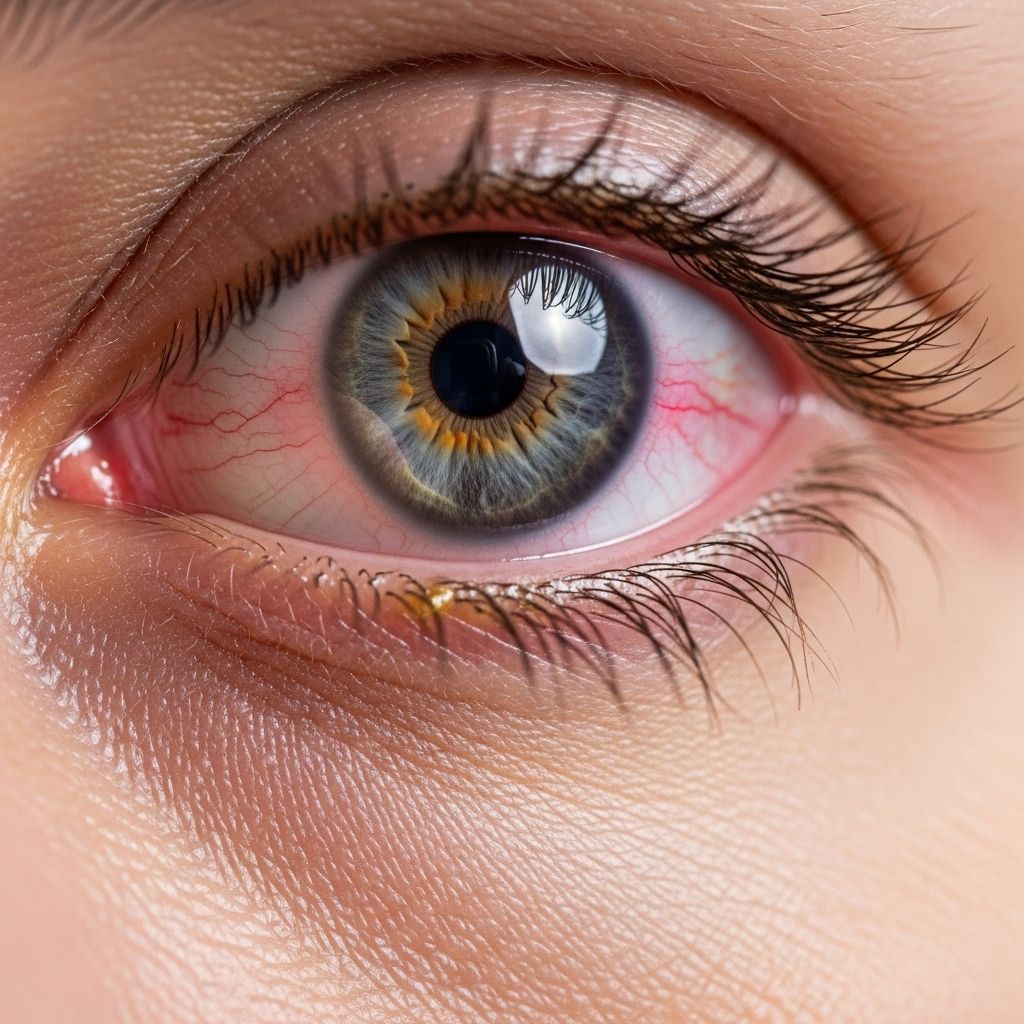How To Get Rid Of Pink Eye: Symptoms, Causes, and Effective Treatments
Clean habits and soothing approaches ease eye redness and halt infection spread.

How To Get Rid Of Pink Eye (Conjunctivitis): Remedies, Causes & Prevention
Pink eye, also known as conjunctivitis, is a common eye condition marked by redness, irritation, and discharge from one or both eyes. It can be uncomfortable, contagious, and sometimes a cause for concern—but with the right approach, you can find effective relief and prevent its spread.
Table Of Contents
- What Is Pink Eye?
- Symptoms of Pink Eye
- Types and Causes of Pink Eye
- How To Get Rid Of Pink Eye
- Home Remedies for Managing Pink Eye
- When To See a Doctor
- Prevention: How To Stop Pink Eye From Spreading
- Frequently Asked Questions (FAQs)
What Is Pink Eye?
Pink eye, or conjunctivitis, is an inflammation or infection of the transparent membrane (conjunctiva) that lines your eyelid and covers the white part of your eyeball. When the tiny blood vessels in the conjunctiva become inflamed, they’re more visible, causing the whites of your eyes to appear reddish or pink.
Symptoms of Pink Eye
- Redness in one or both eyes
- Itching, burning, or gritty feeling in the eyes
- Watery or thick discharge from the eye, which may crust over the eyelashes (especially after sleep)
- Tearing or excessive watery eyes
- Increased sensitivity to light
- Swollen eyelids
- Blurry vision (usually mild and transient)
Symptoms usually develop rapidly and can affect one or both eyes. In viral or bacterial conjunctivitis, discharge and eye crusting are common, while allergic conjunctivitis typically causes intense itching and tearing.
Types and Causes of Pink Eye
Understanding the cause of conjunctivitis is crucial because treatment varies based on type. Main causes include:
| Type | Main Cause | Contagious? | Key Characteristics |
|---|---|---|---|
| Viral conjunctivitis | Viruses (often adenovirus) | Yes | Associated with colds; watery discharge; spreads easily |
| Bacterial conjunctivitis | Bacteria (e.g., Staphylococcus, Streptococcus) | Yes | Thick, yellow/green discharge; eyelid crusting; can affect both eyes |
| Allergic conjunctivitis | Allergens (pollen, dust, pet dander) | No | Intense itching, tearing, accompanied by other allergy symptoms like sneezing; both eyes usually affected |
| Irritant conjunctivitis | Chemical splash, foreign objects | No | Redness, tearing after exposure to an irritant; resolves with eye rinsing |
| Neonatal conjunctivitis | Infection, irritants, or blocked tear duct in newborns | Yes (often) | Serious; requires urgent medical attention |
| Giant papillary conjunctivitis | Long-term use of contact lenses, reaction to foreign materials | No | Contact lens users; swelling, itching, mucus; improves with lens removal |
How To Get Rid Of Pink Eye
Pinken eye treatment depends on its underlying cause. Here’s a breakdown of the most effective strategies for each kind:
1. Viral Conjunctivitis
- Usually runs its course in 4–7 days
- Antibiotics are ineffective for viruses
- Prescription antiviral drops or pills may be needed for herpes simplex viral infections
Key advice: Focus on comfort measures (see home remedies below), avoid touching or spreading discharge, and practice scrupulous hygiene to prevent transmission.
2. Bacterial Conjunctivitis
- Antibiotic eye drops or ointments are often prescribed by a doctor
- Improvement typically occurs within a few days of starting antibiotics; course usually lasts 5–7 days
- Oral antibiotics may be required for severe, persistent, or sexually transmitted causes
Key advice: Use medication exactly as directed and complete the full course even after symptoms improve.
3. Allergic Conjunctivitis
- Antihistamine and anti-allergy eye drops help relieve symptoms
- Non-prescription (over-the-counter) or prescription options are available
- Avoid the trigger allergen (pollen, animal dander, dust) if possible
4. Irritant Conjunctivitis
- Immediately rinse eye with plenty of clean water for several minutes
- Most cases resolve quickly after flushing out the irritant
- If symptoms persist, or if the irritant is caustic (like lye, acid, or bleach), seek medical care immediately
5. Special Cases: Pink Eye in Newborns and Contact Lens Wearers
- Newborns: Any pink eye is a medical emergency; prompt doctor visit is critical to prevent complications
- Contact lens users: Stop wearing lenses during infection. Disinfect or replace all lenses, cases, and accessories after recovery. Consult your doctor for further advice
Home Remedies for Managing Pink Eye
While medications are essential for some cases, symptom relief and support at home are important for all types. Try these safe, doctor-recommended strategies:
- Apply a cool or warm compress to the closed eyes to soothe irritation
- Gently clean away discharge with a clean, damp cloth
- Use artificial tears (lubricating eye drops) to keep eyes moist and comfortable
- Avoid rubbing your eyes, which can worsen symptoms and increase risk of spread
- If using eye drops, do not touch the tip to your eye or lids
- Throw away tissues and wash hands after touching your face or eyes
- Avoid makeup and discard any products used while you had symptoms
Note: These measures help manage discomfort but do not substitute for necessary medical care when indicated.
When To See a Doctor
- Severe pain, vision changes, or light sensitivity develop
- Your symptoms are severe or persist longer than 2 weeks
- You experience intense redness, swelling, or green/yellow discharge
- You develop symptoms after an eye injury or exposure to a hazardous substance
- Neonates (newborns) or immunocompromised individuals show signs of pink eye
- You wear contact lenses and suspect pink eye, especially if vision is affected or pain is present
Prompt medical attention can help avoid complications such as corneal ulcers, vision loss, or the spread of infection.
Prevention: How To Stop Pink Eye From Spreading
- Wash hands frequently with soap and water
- Avoid touching or rubbing your eyes
- Use a clean towel and washcloth every day; do not share with others
- Change pillowcases and linens often during an active infection
- Do not share eye makeup, contact lenses, or eye care products
- Stay home from school, work, or group settings until the contagious period passes (often 24–48 hours after treatment begins, or when symptoms resolve)
- Disinfect or discard any eye products or contact lens accessories used while infected
Strict hygiene is the best defense against spreading pink eye, especially in households, schools, and healthcare settings.
Frequently Asked Questions (FAQs)
Q: Is pink eye contagious?
A: Yes, bacterial and viral conjunctivitis are highly contagious. They spread through direct contact with eye secretions or contaminated surfaces. Allergic and irritant conjunctivitis, however, are not contagious.
Q: How long does pink eye last?
A: Viral conjunctivitis typically lasts 4–7 days, while bacterial conjunctivitis can improve within a few days of starting antibiotics but may require 5–7 days. Allergic conjunctivitis persists as long as you’re exposed to allergens, but symptoms improve quickly once the trigger is removed.
Q: Can I go to work or school with pink eye?
A: It’s best to stay home while you have active symptoms, especially if you have viral or bacterial conjunctivitis. Wait at least 24 hours after starting antibiotics (if prescribed) or until symptoms subside to return to group settings, as this helps prevent spreading the infection.
Q: When is pink eye considered an emergency?
A: Seek immediate care if you experience severe pain, vision loss, intense redness, light sensitivity, or symptoms in a newborn. Also, urgent medical care is needed for chemical injuries to the eye.
Q: Will antibiotics help all types of pink eye?
A: No. Antibiotics only work for bacterial conjunctivitis. They are ineffective against viral or allergic causes and are not recommended unless bacterial infection is confirmed or strongly suspected.
Key Takeaways
- Pink eye is common and mostly mild, but needs prompt attention—especially in newborns or contact lens users.
- Identify the cause (viral, bacterial, allergic, or irritant) to guide effective treatment.
- Simple home care relieves many symptoms, but see a healthcare provider if symptoms are severe, persistent, or unusual.
- Meticulous hygiene and sharing prevention can stop its spread to others.
References
- https://www.mayoclinic.org/diseases-conditions/pink-eye/symptoms-causes/syc-20376355
- https://www.webmd.com/eye-health/eye-health-conjunctivitis
- https://www.mayoclinic.org/diseases-conditions/pink-eye/diagnosis-treatment/drc-20376360
- https://www.cdc.gov/conjunctivitis/about/index.html
- https://my.clevelandclinic.org/health/diseases/pink-eye-conjunctivitis
- https://www.aurorahealthcare.org/services/eye-care/pink-eye-conjunctivitis
- https://www.esht.nhs.uk/wp-content/uploads/2020/12/0869.pdf
- https://www.nei.nih.gov/learn-about-eye-health/eye-conditions-and-diseases/pink-eye
Read full bio of Sneha Tete












